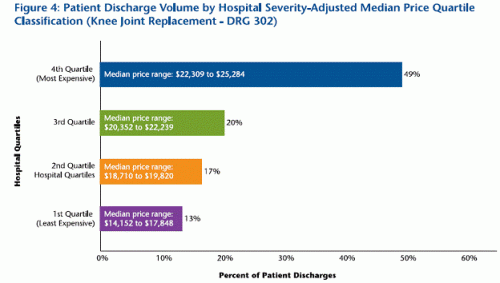The executives at Partners and other high-priced Massachusetts hospitals will have some explaining to do at the upcoming hearings. The merger creating Partners was blessed by antitrust authorities because of potential efficiencies, despite the market power risks. New data doesn’t appear to support the efficiency story for Partners. From the new report (the older AG report is here) by the MA Division of Health Care Finance & Policy:
“Prices paid for the same hospital inpatient services and for physician and professional services vary significantly for every service examined. There was at least a three-fold difference for every service and for most, a variation of six- or seven-fold.”
A seven-fold price variation is common in airline seats: expect to pay a lot more to sit up front. Price variations could be caused by many factors other than pure, raw market power. The report mentions several possibilities (in fn.6), including quality, acuity, payer mix, service mix and operational costs. Comparative quality information is limited, but what information we have doesn’t match the quality story:
“There is little measurable variation among Massachusetts hospitals based on the available quality metrics related specifically to the 14 selected inpatient services. In contrast, the price variation for those services is significant, and lower priced hospitals are often associated with slightly higher quality scores and vice versa.”
What about payer mix? Were some high-priced hospitals being rewarded for taking more Medicaid patients (the cost-shift hypothesis)? Apparently not:
“There was no correlation between a hospital’s share of Medicaid patients and the prices they received from private payers, with some of the lowest paid hospitals having the highest proportion of Medicaid discharges.”
Were insurance companies able to steer patients to the cheaper facilities? Again, no:
“Data on the selected 14 routine inpatient services indicates that service volume tends to be concentrated in higher paid hospitals. For example, 47 percent of vaginal deliveries occurred in the most highly paid quartile of hospitals.”
The knee joint data was even more striking:
Finally, the health plans had this data for years.
h/t to Rachel Zimmerman and the WBUR team at CommonHealth
UPDATE: From the Boston Globe this morning including this great graphic.


